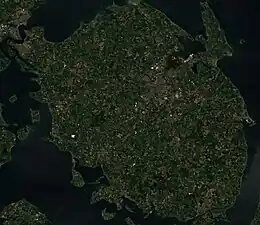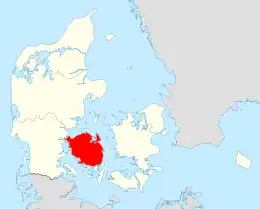Funen
Funen (Danish: Fyn, pronounced [ˈfyˀn]), with an area of 3,099.7 square kilometres (1,196.8 sq mi), is the third-largest island of Denmark, after Zealand and Vendsyssel-Thy. It is the 165th-largest island in the world. It is located in the central part of the country and has a population of 469,947 as of 2020.[1] Funen's main city is Odense, which is connected to the sea by a seldom-used canal. The city's shipyard, Odense Steel Shipyard, has been relocated outside Odense proper.
Native name: Fyn | |
|---|---|
 A Sentinel-2 satellite image of the island | |
 | |
| Geography | |
| Location | Kattegat |
| Coordinates | 55°21′N 10°21′E |
| Area | 2,984.56 km2 (1,152.35 sq mi) |
| Administration | |
Denmark | |
| Region | South Denmark Region |
| Municipality | Several |
| Largest settlement | Odense (pop. 180,302) |
| Demographics | |
| Population | 469,947 (2020) |
| Pop. density | 150/km2 (390/sq mi) |
Funen belongs administratively to the Region of Southern Denmark. From 1970 to 2006 the island formed the biggest part of Funen County, which also included the islands of Langeland, Ærø, Tåsinge, and a number of smaller islands.
Funen is linked to Zealand, Denmark's largest island, by the Great Belt Bridge, which carries both trains and cars. The bridge is in reality three bridges; low road and rail bridges connect Funen to the small island of Sprogø in the middle of the Great Belt, and a long road suspension bridge (the second longest in the world at the time of opening) connects Funen the rest of the way to Zealand, paralleled by a rail tunnel.
Two bridges connect Funen to the Danish mainland, Jutland. The Old Little Belt Bridge was constructed in the 1930s, shortly before World War II for both cars and trains. The New Little Belt Bridge, a suspension bridge, was constructed in the 1970s and is used for cars only.
Apart from the main city, Odense, all major towns are located in coastal areas. Beginning in the north-east of the island and moving clockwise, they are Kerteminde (NE), Nyborg (E), Svendborg (S), Fåborg (SW), Assens (W), Middelfart (NW) and Bogense (N).
The populations of the major cities and towns are, as of 1 January 2018:[2]
- Odense: 178,210
- Svendborg: 27,324
- Nyborg: 17,164
- Middelfart: 15,246
- Fåborg: 7,065
- Assens: 6,209
- Kerteminde: 5,914
- Ringe: 5,912
- Otterup: 5,227
- Bogense: 3,891
Funen was the birthplace of Hans Christian Andersen, the composer Carl Nielsen, American War of Independence combatant Christian Febiger, pop singer MØ and international footballer Christian Eriksen.
The highest natural point on Funen is Frøbjerg Bavnehøj.
Politics
Viking Age
In 2018, on the hill Munkebo Bakke, located in north eastern Funen, have archaeologists found an exceedingly large Viking hall that dates back more than 1,000 years, to around 825 – 1,000 CE. According to the Funen museum experts, this Viking hall is larger than any found on Funen before.[3]
Galgedil is a Viking Age cemetery located in the northern part of Funen. Excavations at the local site revealed 54 graves containing 59 inhumations and 2 cremation burials.[4]
See also
- Broholm
- Den Selvforsynende Landsby
- Egeskov Castle
- Fynske Livregiment
- Horne Church
- Hvedholm Castle
- Korshavn, Denmark
- Skrøbelev Gods
- The Funen Village an open-air museum.
- Funen brachteate in the collections of the National Museum of Denmark.
References
- "Kommuner på landkortet - Danmarks Statistik". Archived from the original on 23 March 2013. Retrieved 3 May 2013.
- "Statistikbanken". statbank.dk. Retrieved 27 September 2018.
- "Danish Archaeologists Stunned After Discovering a New Viking Hall". 3 July 2018.
- Price, T. Douglas; Prangsgaard, Kirsten; Bennike, Pia; Kanstrup, Marie; Frei, Karin Margarita (November 2014). "Galgedil: Isotopic studies of a Viking cemetery on the Danish island of Funen, AD 800–1050". Danish Journal of Archaeology. 3 (2): 129–144. doi:10.1080/21662282.2015.1056634. S2CID 130026632.